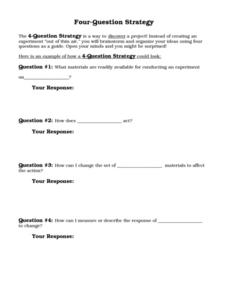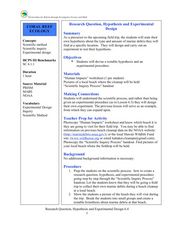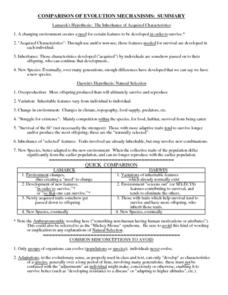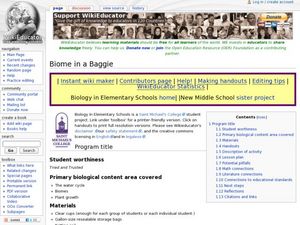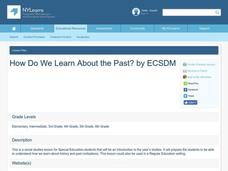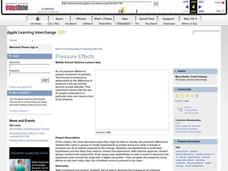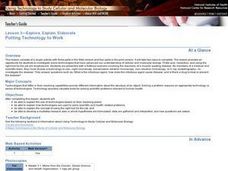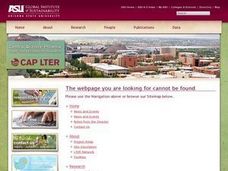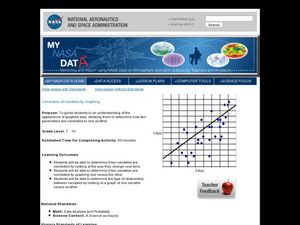Curated OER
Four Question Strategy
In this experimental design worksheet, students brainstorm about a project to do on the topic of their choice. They answer four questions about the materials available, the hypothesis of their experiment and the independent and dependent...
Curated OER
Yeast Cells and their Environment
Pupils study the scientific method and explore how to design an experiment. In this investigative lesson students explore and hypothesis an experiment then carry it out to find the results.
Curated OER
Independent Investigation
For this science worksheet, students write what they want to discover and identify what they feel will happen. Then they design an experiment and write the steps for it in the space provided. Students also create a data table or chart...
Curated OER
Seed Dispersion of Strawberries and Dandelions
Students investigate how seeds are dispersed on land. In this plant biology lesson, students use a dissecting microscope to study strawberry seeds and dandelion seeds, they draw what they see, then create a hypothesis on the seeds...
Curated OER
Testing a Hypothesis
In this hypothesis activity, students learn about the scientific method, particularly how to test a hypothesis by creating an experiment. Students complete 4 short answer questions.
Curated OER
Research Question, Hypothesis and Experimental Design
Learners discuss steps of the scientific process, as well as, observe a picture of the beach that they will visit. Students create a testable hypothesis about marine debris at the beach. In this science lesson, learners create a...
Curated OER
Comparison of Evolution Mechanism
In this comparison of evolution worksheets, students read information about Lamarck's hypothesis of evolution and Darwin's hypothesis of evolution. Students then rate the scenarios given as either supportive of Lamarck's or Darwin's...
Curated OER
Biomes and the water cycle
Students create a desert biome and a prairie biome and see how plants survive in both. In this biomes lesson plan, studnets create their biomes and see how the water cycle effect each biome and plant differently.
Curated OER
Can You Do It?
Students create a simple machine to help with the design of the traditional can opener. In this simple machines lesson plan, students analyze the can opener, and use the design process to solve problems.
Curated OER
How Do We Learn About the Past?
Students examine archaeological discoveries. In this learning about the past activity, students view a "Magic School Bus" video, discuss the role of an archeologist, and complete a graphic organizer. Students discuss a variety of...
Curated OER
Tornado in a Bottle
Best as an introductory lab, this "tornado in a bottle" experiment has learners trying out various methods of getting water in a bottle to create a "tornado." Using a simplified scientific method, they create a hypothesis before...
Curated OER
United States Entry into World War I: Some Hypotheses About U.S. Entry
High schoolers determine the most compelling evidence explaining why the U.S. entered WWI. They read and discuss a handout of reasons why the U.S. entered the war, and take a poll as to which reason was the most compelling.
Curated OER
Pressure Effects
Students, in groups, create experiments to predict and prove what a change in pressure can do to objects exposed to the change. They use AppleWorks to write their hypotheses and the steps they need to conduct the experiment.
Curated OER
Technology-Lesson 3-Putting Technology to Work
Students explain the use of different technologies based on their resolving power. Explain how technologies are used to solve scientific and health-related problems. Explain the concept of using right tool for the job and develop a multi...
Curated OER
United States Entry into World War I: A Documentary Chronology of World War I
Students identify several important events that led to U.S. involvement in World War I. They examine different explanations, form an opinion about the evidence for each rationale and then create a slideshow to present their findings.
Curated OER
Exploration of 'pill bugs'
Fifth graders define words. They create a dichotomous key. After carefully examining pill bugs, 5th graders record observations. They compare and contrast habitats of pillbugs.
Curated OER
California's Golden History: 1848-1880
Using a variety of online resources, learners study life and society in California during the gold rush. They use a map to identify area where gold was located, explore pre-selected websites, describe mining practices, and create an...
Curated OER
Correlation of Variables by Graphing
Middle and high schoolers use a spreadsheet to graph data. In this graphing lesson, learners determine how two parameters are correlated. They create a scatter plot graph using a computer spreadsheet.
Curated OER
Wind Power
What a wonderful way to explore wind power! Through this lesson, learners get a background in the history of wind power, create their own wind turbine, and the test their designs. This is a terrific way to tie scientific principles to...
Baylor College
Serving Sizes
Are serving sizes for different foods always appropriate for what you need? In this hands-on activity, learners work in groups to estimate what one serving size of various foods are, and then evaluate their hypotheses by measuring...
Howard Hughes Medical Institute
Using DNA to Explore Lizard Phylogeny
In a fun and interactive two-day lesson, learners sort anole lizard pictures by appearance. Next, they watch a video about the anoles and re-sort based on the information in the video. In addition to physical characteristics, budding...
Curated OER
Comparing Countries
Students compare facts about different countries. In this comparing lesson, students collect information about the US and another country and compare them. Students locate countries on the map and make a hypothesis about the lives of...
Curated OER
Permeability and Porosity of Somerset County Sediments
Students predict and test the permeability and porosity of sediments in Somerset County, New Jersey. They discuss what how porous they think the sediment of HMS grounds is and why. Students walk around the HMS campus and collect six...
Curated OER
Particle Depostition Lab
Students collect, study and observe the pollution in our air. They list three kinds of pollution that they think is in our air. Students comprehend that the atmosphere is almost completely made up of invisible gaseous substances. They...
